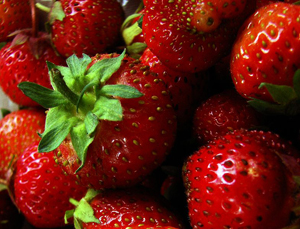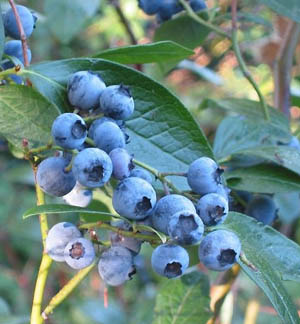
See also: North Carolina State Symbols and Official Adoptions main page
In 2001, the General Assembly named the strawberry as the official Red Berry of North Carolina and named the blueberry as the official Blue Berry of the state (Session laws, 2001, c. 488). The same session law declared the Scuppernong grape to be North Carolina's official state fruit.
Selection as State Berries
The selection of the North Carolina state fruit and berries was an extremely long and contentious process. It began in February of 2001, when a class of fourth graders from Tommy’s Road Elementary School in Wayne county petitioned for the strawberry to become the official state fruit. Their proposal was sponsored by Rep. Carolyn Russell, and won the backing of the North Carolina House of Representatives. In September, however, fourth and fifth graders from Manteo Elementary School in Dare County presented a proposal to make the scuppernong grape the state fruit, backed by Sen. Fountain Odom of Mecklenburg. In October, the senate proposed compromise legislation making the Scuppernong grape the state fruit and the blueberry and strawberry the state berries. The compromise was brought back to the students of Wayne county, who rejected it. Eventually, after much debate between the House and the Senate, the grape/strawberry/blueberry compromise prevailed and went to Governor Mike Easley for his signature. The Wayne County strawberry supporters submitted a last effort for their cause, writing to the Governor and asking him to use his veto power to reject the bill. Nevertheless, on December 16th, the bill was signed into law.
The fruit debate occurred during the longest and most expensive legislative session in North Carolina history. Several congressmen at the time complained about how bills like the symbol proposals caused them to ‘fritter away’ time debating non-essential issues. Other legislators disagreed, citing the debate as an investment in activating young citizen involvement in the legislative process.
About the Strawberry and Blueberry
Strawberries (genus fragaria) originated in Europe. They are produced commercially for fresh consumption or to be frozen, canned, preserved, or juiced. They are a highly perishable fruit and are generally grown near areas of consumption or processing. Strawberries can grow in a wide range of soils and climates, though they are susceptible to drought.
Nutritionally, strawberries are high in Vitamin C and A, and supply 8% of the RDA (Recommended Dietary Allowance), for Iron. There are only 60 calories in a cup of fresh berries and zero grams of fat. They are usually harvested in the spring, from early April until early June. In 2016 North Carolina planted 1,300 acres of strawberries valued at nearly 27 million dollars. According to the United States Department of Agriculture, North Carolina produces the 3rd most strawberries in the country.
A cup of blueberries (genus vaccinium) supplies 50% of the RDA for Vitamin C, as well as 22% of the fiber recommended for a healthy diet. They grow in highly acidic and moist soils, usually in areas with cooler climates. The southern rabbiteye blueberry is frequently grown in the Southeast as it can withstand higher temperatures. 97.6% of North Carolina blueberries are grown in the Coastal Region, with 2.4% grown in the rest of the state. In 2016 North Carolina harvested 7,200 acres of blueberries for a crop of over 46 million pounds. According to the United States Department of Agriculture, North Carolina produces the 6th most blueberries in the country.
The session law itself explains how important these two berries are to the agricultural economy of the state.
Both berries are grown throughout the state, and consumers can pick their own berries at farms from one end of North Carolina to the other. The NC Department of Agriculture provides a list of pick-your-own farms at NC Farm Fresh.

North Carolina Session Law, 2001, c. 488
HOUSE BILL 382
PART I. NORTH CAROLINA'S HERITAGE OF FARMING.
Whereas, North Carolina's economy originated and developed as an agrarian economy with a cornucopia of fruits and vegetables; and
Whereas, the State takes great pride in its rich heritage of farming; and
Whereas, there are still many families who base their livelihood in farming and who are continuing the North Carolina tradition of producing goods from our land; and
Whereas, one of the main sources of agricultural production in the State is the production of fruits and berries of several varieties; and...
PART III. THE STRAWBERRY AND THE BLUEBERRY.
Whereas, there are over 1,700 acres of strawberries and over 3,600 acres of blueberries harvested in North Carolina each year; and
Whereas, in 2000, strawberry growers in the State produced 23,000,000 pounds of strawberries, yielding $17,325,000 in revenues; and
Whereas, in 2000, blueberry growers in the State produced 17,500,000 pounds of blueberries, resulting in an increase in the State's economy of over $18,000,000 in revenues; and
Whereas, these delicious berries are a good source of vitamins, a number of life-sustaining minerals, and dietary fiber;
Whereas, the blueberry is an antioxidant, which has been proven to reduce cholesterol and lower the risk of heart disease; and Whereas, each year the Town of Chadbourn in Columbus County hosts the North Carolina Strawberry Festival, which is one of the most celebrated traditions in the State; and
Whereas, the State of North Carolina does not have an official fruit nor an official berry; Now, therefore,
The General Assembly of North Carolina enacts:
SECTION 1. Chapter 145 of the General Statutes is amended by adding a new section to read:
"§ 145-18. State fruit and State berries.
(a) The official fruit of the State of North Carolina is the Scuppernong grape (Vitis genus).
(b) The official red berry of the State is the strawberry (Fragaria genus).
(c) The official blue berry of the State is the blueberry (Vaccinium genus)."
SECTION 2. This act is effective when it becomes law.
In the General Assembly read three times and ratified this the 5th day of December, 2001.
s/ Beverly E. Perdue
President of the Senate
s/ James B. Black
Speaker of the House of Representatives
s/ Michael F. Easley
Governor
Approved 6:58 p.m. this 16th day of December, 2001